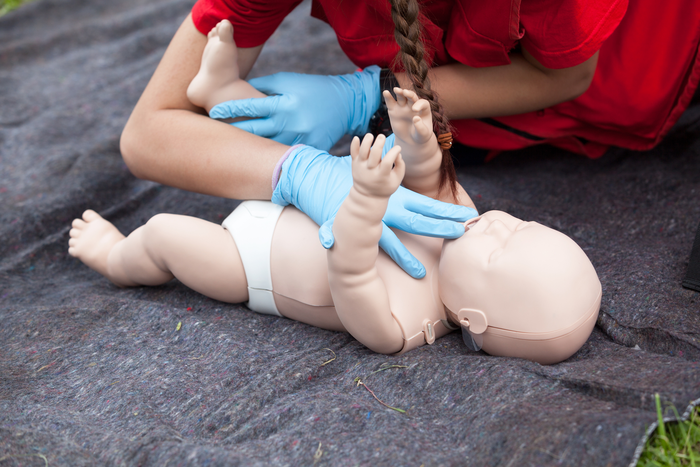
One of the most stressful emergency calls a paramedic will encounter is a child who can’t breathe. Pediatric emergencies are stressful enough; in the case of an obstructed airway, stress levels can go through the roof.
As with any obstruction, your primary objective is to relieve or remove whatever is blocking the airway. In the case of a foreign body obstruction, if basic life support maneuvers fail to dislodge the object and the patient loses consciousness or, in a worst-case scenario, goes into cardiac arrest, begin CPR.
If the object is visible, remove using pediatric forceps or perform a finger sweep. If still obstructed, try ventilating with a bag valve and consider endotracheal intubation. Hopefully, your efforts will be rewarded with relief from the obstruction and a return to patency.
But what if the obstruction is not a foreign object? What if the child was struck by a car, resulting in massive facial trauma and excessive bleeding into the oral cavity? Or the patient with a diminished level of consciousness who suddenly begins vomiting? If not immediately corrected, the results will be the same, for blood, vomit, and secretions can be just as lethal as a foreign object, if not swiftly removed.
Your only recourse is immediate suctioning using your portable suction unit. There is no other way to alleviate a clogged airway. Removing vomit, controlling bleeding and secretions, and visualizing the cords during intubation can only be achieved via effective suctioning. Let’s discuss some of the considerations when performing emergency suction in children.
Identify the Need
Recognizing the need for suction is a critical first step in clearing the airway. During your initial assessment, take a good look at your patient. The patient’s general appearance will provide a wealth of information as to the status of his or her airway.
- Is the patient awake and alert, or limp and lethargic?
- Is he or she sitting in a tripod or sniffing position?
- What is his or her skin color?
- Is he or she working hard to breathe?
- Is he or she grunting?
- Is he or she exhibiting retractions or nasal flaring?
- Is he or she emitting abnormal airway sounds, like grunting, snoring, wheezing, or stridor?
- Is his or her respiratory rate adequate? Is it too fast or too slow?
- What do the patient’s lungs sound like?
- What is his or her pulse oximetry reading?
Each of these considerations will provide valuable information as to the status of the patient’s airway.
Ask the Right Questions
Children are typically ineffective communicators, especially when sick and scared. If in respiratory distress, they may not be capable of answering questions, even if they want to. Engage the parent or caregiver. Here are a few quick questions that will help you identify the underlying cause of distress:
- Is this the first time your child has had trouble breathing?
- Has he or she experienced this same issue in the past?
- Is he or she taking any medications?
- Has he or she been running a fever?
- Has he or she had a chest injury?
- Did the problem start suddenly or is it chronic in nature?
The answers to these questions will indicate whether the patient has an underlying condition or if the issue is something new.
Limited Air Movement?
The respiratory emergency may be caused by an underlying functional problem with air exchange. These include:
- Airway obstruction—conditions such as asthma, croup, foreign body, or bronchiolitis
- Decreased central respiratory drive—secondary to head injury or intoxication
- Traumatic injury—rib fractures, pulmonary contusion, or pneumothorax
- Restriction of chest wall movement—traumatic injury, severe scoliosis, or kyphosis (anterior curvature of the spine)
- Chest wall muscle fatigue—prolonged work of breathing, muscular dystrophy
In these situations, if you cannot correct the problem (pneumothorax or foreign body), your intervention may be to suction when needed and assist with ventilations until the patient is delivered to an appropriate facility.
Signs of Impending Failure
It is critical that you recognize impending respiratory failure. Since your patient may be unable to communicate, here are the signs:
- Exhaustion—the patient is too fatigued to move adequate air
- Altered appearance—blank gaze, flaccid limbs, diminished level of consciousness
- Inability to recline—the patient is forced to sit upright (tripod or sniffing position)
- Interrupted speech—the child is unable to articulate full sentences without gasping
- Severe retractions—increased work of breathing
- Decreased air movement—listen to the lungs, monitor pulse oximetry
Suction Considerations
If the child is exhibiting signs of impending respiratory failure and is unable to clear his or her airway, it is time to crank up the portable suction unit. Here are a few tips:
- Make sure your suction unit is operational by checking it at the start of each shift.
- Use the appropriately sized catheter (small tip) to prevent traumatizing oral tissues.
- Dial back the suction pressure for small children to avoid overaggressive suctioning.
- Use a small, flexible catheter to suction the nose and mouth of very young children.
- Use a sterile technique when suctioning an endo- or nasotracheal tube.
- Stow the portable suction machine in the airway or pedi bag, so that it is always there when you need it.
Emergency suction in children requires a few special considerations. This simple, life-saving procedure must be part of a targeted strategy when treating the youngest of patients.
Editor's Note: This blog was originally published in February, 2018. It has been re-published with additional up to date content.
















